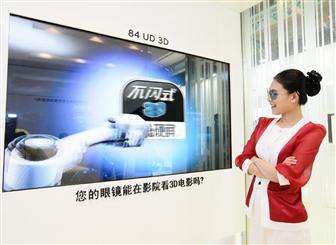December 20, 2010 report
LG unveils FPR polarized 3D television

(PhysOrg.com) -- LCD manufacturer LG Display has unveiled its new polarized three-dimensional television technology to 250 participants at a launch press conference in Beijing, China.
The new technology is dubbed FPR for Film Patterned Retarder, which is said to be vastly superior to previous 3D liquid crystal display (LCD) systems. The current system uses a frame sequential method and the display is viewed using liquid crystal shutter glasses (SG). The new technology uses a polarized film substrate in the panel and is viewed using polarized film glasses. Using film instead of glass as a substrate for the patterned retarder panel also cuts the costs of the system considerably.
The new technology reduces the vertical resolution to half that of a panel and produces a near-4K resolution full high definition 3D picture that is extremely sharp and bright. The system was demonstrated at the press conference on an 84-inch display.
The polarized film glasses eliminate the flicker and crosstalk problems associated with shutter glasses. The glasses do not require power from batteries or USB charge, and are also lighter and more comfortable than SG and emit no electromagnetic radiation, which means viewers can use the glasses for hours without discomfort.
A representative of the Beijing Ophthalmology Research Institute presented the results of a comparison of FPR technology to SG. The study included 38 adult subjects, and found that the FPR system produced less eye fatigue than the SG.
Chief Executive Officer of LG Display, Young Soo Kwon, said at the conference that the company was launching the “FPR 3D era” in China and will focus on the new technology because the company believes FPR is superior "in all aspects" to the previous 3D systems.
According to Yang Dong Wen, vice president of Skyworth, a leading company in the Chinese LCD television market, FPR 3D products are clearly different to existing 3D televisions, and their introduction should see China’s 3D television market expand to more than eight million units in the coming year. The FPR system should also boost sales of 3D televisions because it will solve many of the problems in demonstrating 3D TVs in stores, such as dead batteries in the 3D glasses, synchronization errors, and occasional interruptions that occur when several 3D televisions are placed near to each other.
LG Display said the company is aiming to achieve 70 percent of 3D LCD television sales in 2011 with the help of FPR technology. LG high definition (HD) televisions featuring FPR technology are already in production and will go on sale early in the new year, followed by the US in February, and then Europe and the UK in April or May.
Other participants at the conference agreed to cooperate with LG Display to promote the sales of polarized 3D LCD televisions next year. The major companies represented included LG Electronics, Toshiba, Vizio, Skyworth, Changhong, TCL, Konka and Hisense.
© 2010 PhysOrg.com




















